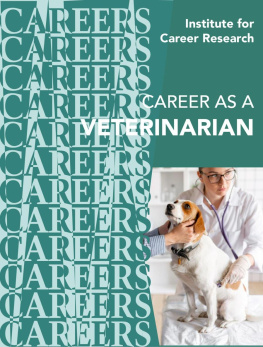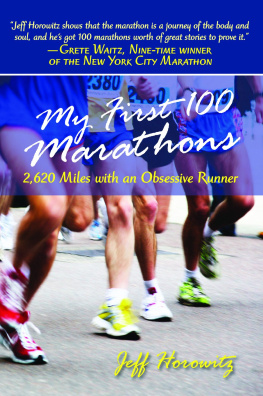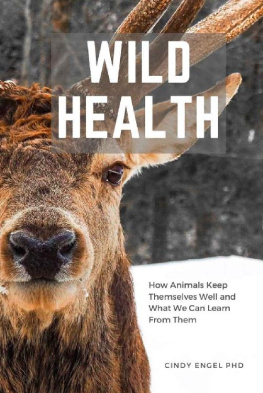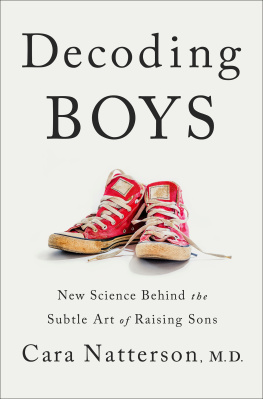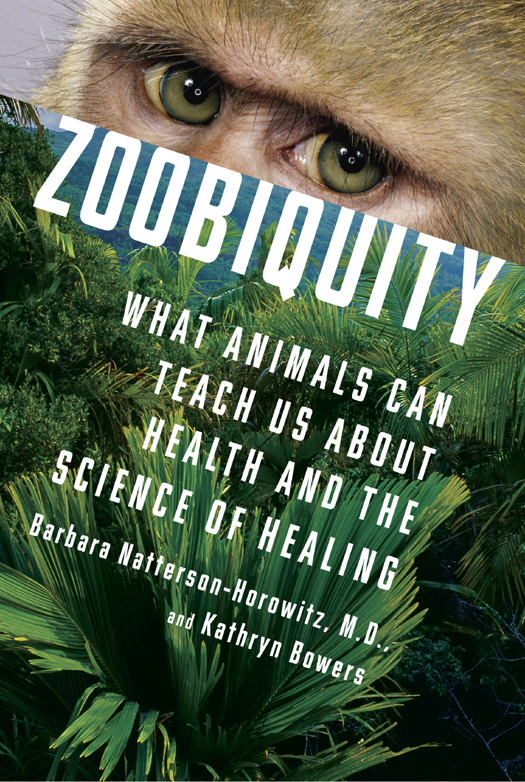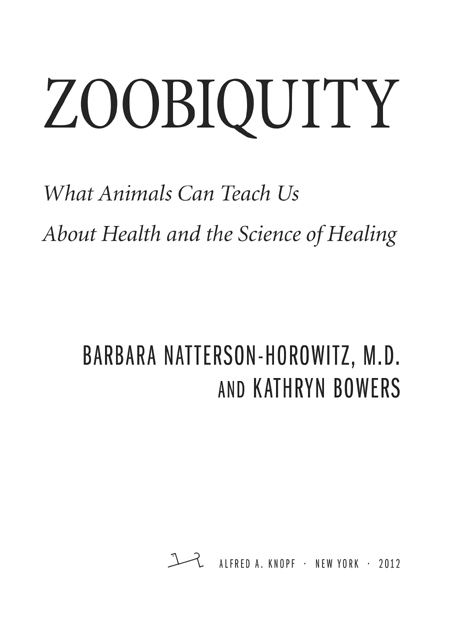THIS IS A BORZOI BOOK
PUBLISHED BY ALFRED A. KNOPF
Copyright 2012 by Zoobiquity, LLC
All rights reserved. Published in the United States by
Alfred A. Knopf, a division of Random House, Inc., New York,
and in Canada by Random House of Canada Limited, Toronto.
www.aaknopf.com
Knopf, Borzoi Books, and the colophon are
registered trademarks of Random House, Inc.
Library of Congress Cataloging-in-Publication Data
Natterson-Horowitz, Barbara.
Zoobiquity / Barbara Natterson-Horowitz and Kathryn Bowers.1st ed.
p. cm.
Includes bibliographical references.
eISBN: 978-0-307-95838-9
I. Bowers, Kathryn. II. Title.
[DNLM: 1. Disease Models, Animal. 2. Pathology. 3. Pathology, Veterinary.
4. Physiology, Comparative. 5. Psychology, Comparative. QZ 33]
636.089607dc23 2012005051
Jacket images: (top) Jill Greenberg, courtesy of ClampArt Gallery,
NYC; (bottom) David Noton Photography / Alamy
Jacket design by Chip Kidd
v3.1
For Zach, Jenn, and CharlieBNH
For Andy and EmmaKSB
Contents
ONE Dr. House, Meet Doctor Dolittle
Redefining the Boundaries of Medicine
TWO The Feint of Heart
Why We Pass Out
THREE Jews, Jaguars, and Jurassic Cancer
New Hope for an Ancient Diagnosis
FOUR Roar-gasm
An Animal Guide to Human Sexuality
FIVE Zoophoria
Getting High and Getting Clean
SIX Scared to Death
Heart Attacks in the Wild
SEVEN Fat Planet
Why Animals Get Fat and How They Get Thin
EIGHT Grooming Gone Wild
Pain, Pleasure, and the Origins of Self-Injury
NINE Fear of Feeding
Eating Disorders in the Animal Kingdom
TEN The Koala and the Clap
The Hidden Power of Infection
ELEVEN Leaving the Nest
Animal Adolescence and the Risky Business of Growing Up
Authors Note
Although this work is a journalistic collaboration between two authors, we chose for stylistic reasons to write the book from Dr. Natterson-Horowitzs point of view. We felt her journey from focusing solely on human medicine to a broader, species-spanning approach demanded a first-person narrative structure. Most interviews in the book were conducted by both authors, although in a few cases only one author did the questioning. The final book is the result of a true partnership not just between Dr. Natterson-Horowitz and Ms. Bowers but among the many physicians, veterinarians, biologists, researchers, other dedicated professionals, and patients (whose names weve changed where necessary) who so generously shared their time, scholarship, and experiences with us.
ONE
Dr. House, Meet Doctor Dolittle
Redefining the Boundaries of Medicine
In the spring of 2005, the chief veterinarian of the Los Angeles Zoo called me, an urgent edge to his voice.
Uh, listen, Barbara? Weve got an emperor tamarin in heart failure. Any chance you could come out today?
I reached for my car keys. For thirteen years Id been a cardiologist treating members of my own species at the UCLA Medical Center. From time to time, however, the zoo veterinarians asked me to weigh in on some of their more difficult animal cases. Because UCLA is a leading heart-transplant hospital, Id had a front-row view of every type of human heart failure. But heart failure in a tamarina tiny, nonhuman primate? That Id never seen. I threw my bag in the car and headed for the lush, 113-acre zoo nestled along the eastern edge of Griffith Park.
Into the tiled exam room the veterinary assistant carried a small bundle wrapped in a pink blanket.
This is Spitzbuben, she said, lowering the animal gently into a Plexiglas-fronted examination box. My own heart did a little flip. Emperor tamarins are, in a word, adorable. About the size of kittens, these monkeys evolved in the treetops of the Central and South American rain forests. Their wispy, white Fu Manchustyle mustaches droop below enormous brown eyes. Swaddled in the pink blanket, staring up at me with that liquid gaze, Spitzbuben was pushing every maternal button I had.
When Im with a human patient who seems anxious, especially a child, I crouch close and open my eyes wide. Over the years Ive seen how this can establish a trust bond and put a nervous patient at ease. I did this with Spitzbuben. I wanted this defenseless little animal to understand how much I felt her vulnerability, how hard I would work to help her. I moved my face up to the box and stared deep in her eyesanimal to animal. It was working. She sat very still, her eyes locked on mine through the scratched plastic. I pursed my lips and cooed.
Sooo brave, little Spitzbuben
Suddenly I felt a strong hand on my shoulder.
Please stop making eye contact with her. I turned. The veterinarian smiled stiffly at me. Youll give her capture myopathy.
A little surprised, I did as instructed and got out of the way. Human-animal bonding would have to wait, apparently. But I was puzzled. Capture myopathy? Id been practicing medicine for almost twenty years and had never heard of that diagnosis. Myopathy, surethat simply means a disease that affects a muscle. In my specialty, I see it most often as cardiomyopathy, a degradation of the heart muscle. But what did that have to do with capture?
Just then, Spitzbubens anesthesia took effect. Time to intubate, the attending veterinarian instructed, focusing every person in the room on this critical and sometimes difficult procedure. I pushed capture myopathy out of my mind to be fully attentive to our animal patient.
But as soon as we were finished and Spitzbuben was safely back in her enclosure with the other tamarins, I looked up capture myopathy. And there it wasin veterinary textbooks and journals going back decades. There was even an article about it in Nature, from 1974. Animals caught by predators may experience a catastrophic surge of adrenaline in their bloodstreams, which can poison their muscles. In the case of the heart, the overflow of stress hormones can injure the pumping chambers, making them weak and inefficient. It can kill, especially in the case of cautious and high-strung prey animals like deer, rodents, birds, and small primates. And there was more: locking eyes can contribute to capture myopathy. To Spitzbuben, my compassionate gaze wasnt communicating, Youre so cute; dont be afraid; Im here to help you. It said: Im starving; you look delicious; Im going to eat you.
Though this was my first encounter with the diagnosis, parts of it were startlingly familiar. Cardiology in the early 2000s was abuzz with a newly described syndrome called takotsubo cardiomyopathy. This distinctive condition presents with severe, crushing chest pain and a markedly abnormal EKG, much like a classic heart attack. We rush these patients to an operating suite for an angiogram, expecting to find a dangerous blood clot. But in takotsubo cases, the treating cardiologist finds perfectly healthy, clean coronary arteries. No clot. No blockage. No heart attack.
On closer inspection, doctors notice a strange, lightbulb-shaped bulge in the left ventricle. As the pumping engines for the circulatory system, ventricles must have a particular ovoid, lemonlike shape for strong, swift ejection of blood. If the end of the left ventricle balloons out, as it does in takotsubo hearts, the firm, healthy contractions are reduced to inefficient spasmsfloppy and unpredictable.


